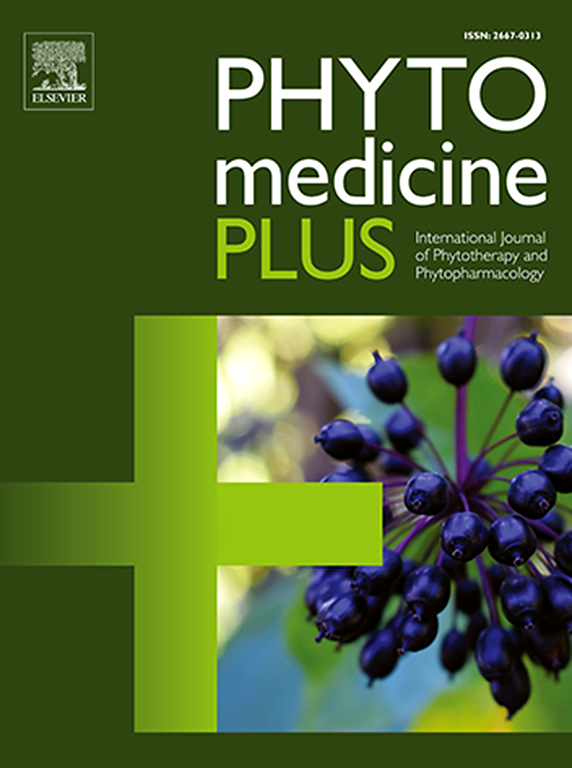Therapeutic potential of Asplenium caudatum in Aluminum Chloride-induced Alzheimer’s diseases: An insight of integrative approaches
Q3 Pharmacology, Toxicology and Pharmaceutics
引用次数: 0
Abstract
Background
Asplenium caudatum, or Khagpie, is a plant native to Africa and Southeast Asia that tribal communities have long relied upon for medicinal purposes.
Purpose
This study aims to evaluate the antioxidant and anti-Alzheimer’s potential of Asplenium caudatum by in vitro, in vivo, and in silico methods.
Methods
We have evaluated the in vitro free radical scavenging ability and phenolic content assays of aqueous (ASP-W) and hexane (ASP-H) extracts. Moreover, the inhibitory activities against AChE, BuChE, ROCK II, GSK-3β, LOX-5, TNF-α, COX-2, and Na+K+ATPase, along with the levels of oxidative stress biomarkers (malondialdehyde, reduced glutathione, nitric oxide, catalase, and superoxide dismutase activity) were also studied. Histopathological alterations in the hippocampus and cerebral cortex of the rat brain were also assessed.
Results
It was found that the ASP-W and ASP-H fractions had much stronger radical scavenging activity than the other fractions. Based on in vitro results ASP-H and ASP-W fractions were chosen for in vivo studies in AlCl3-stimulated cognitive damage. Cognitive function was evaluated using the Morris water maze test. Cognitive impairment caused by AlCl3 was prevented by the ASP-H and ASP-W fractions in a dose-dependent manner in male Wistar rats. Moreover, the substantial improvement of cholinergic function by reducing oxidative stress, and the suppression of GSK-3β, ROCK II, LOX-5, TNF-α, COX-2, and Na+K+ATPase expression and activity were observed. In silico studies demonstrated the strong affinity of phytochemicals towards AD biomarkers, confirming their function in preventing and regulating AD pathogenesis.
Conclusion
Consequently, the findings point to an anti-Alzheimer's ability of the ASP-W and ASP-H fractions.

尾藤在氯化铝诱导的阿尔茨海默病中的治疗潜力:综合方法的见解
尾螺,或Khagpie,是一种原产于非洲和东南亚的植物,部落社区长期以来一直依赖于药用。目的通过体外、体内和计算机实验评价尾藤的抗氧化和抗阿尔茨海默病的作用。方法采用体外自由基清除能力和酚类含量测定方法,对水提物(ASP-W)和己烷提物(ASP-H)的体外自由基清除能力进行评价。此外,还研究了其对AChE、BuChE、ROCK II、GSK-3β、LOX-5、TNF-α、COX-2和Na+K+ atp酶的抑制活性,以及氧化应激生物标志物(丙二醛、还原性谷胱甘肽、一氧化氮、过氧化氢酶和超氧化物歧化酶活性)的水平。对大鼠海马和大脑皮层的组织病理学改变也进行了评估。结果发现ASP-W和ASP-H组分具有较强的自由基清除能力。根据体外实验结果,选择ASP-H和ASP-W组分进行alcl3刺激的认知损伤的体内研究。采用Morris水迷宫试验评估认知功能。ASP-H和ASP-W组分对AlCl3引起的雄性Wistar大鼠认知功能损害具有剂量依赖性。此外,通过降低氧化应激可显著改善胆碱能功能,抑制GSK-3β、ROCK II、LOX-5、TNF-α、COX-2和Na+K+ atp酶的表达和活性。硅研究表明,植物化学物质对AD生物标志物具有很强的亲和力,证实了它们在预防和调节AD发病机制中的作用。因此,研究结果表明ASP-W和ASP-H部分具有抗阿尔茨海默病的能力。
本文章由计算机程序翻译,如有差异,请以英文原文为准。
求助全文
约1分钟内获得全文
求助全文
来源期刊

Phytomedicine Plus
Medicine-Complementary and Alternative Medicine
CiteScore
3.70
自引率
0.00%
发文量
178
审稿时长
81 days
期刊介绍:
 求助内容:
求助内容: 应助结果提醒方式:
应助结果提醒方式:


